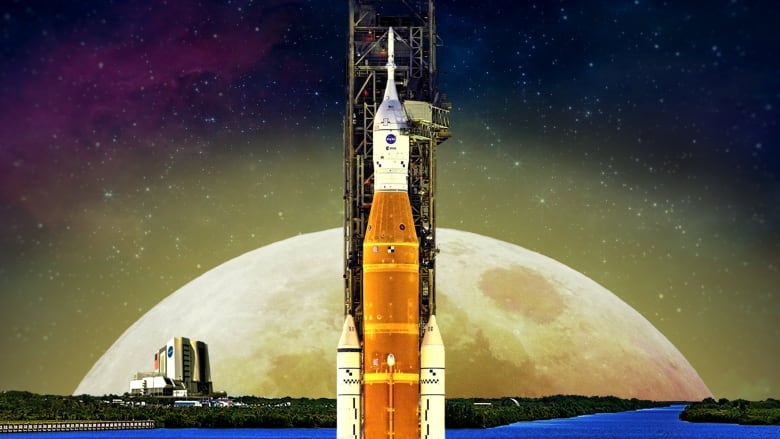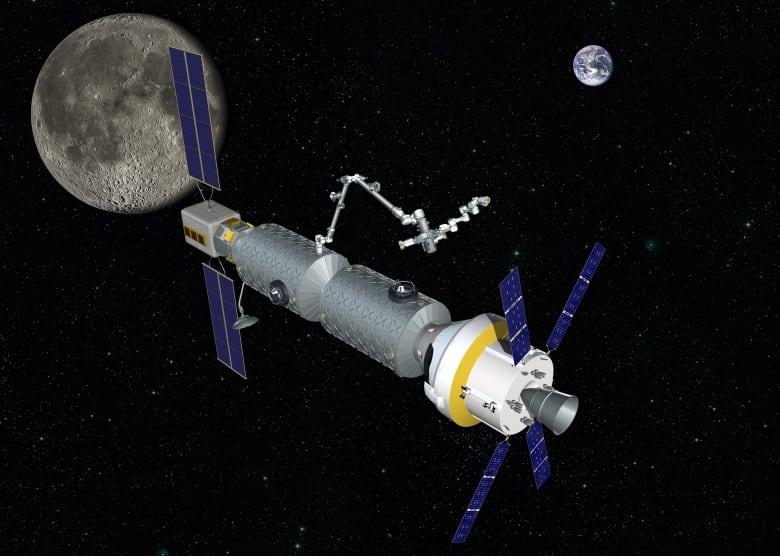Humans are heading back to the moon and Canada is playing a bigger role than you may realize
'I just don't think Canadians realize how awesome we are,' says program manager at the Canadian Space Agency

If all goes as planned, NASA's most powerful rocket yet will roar to life on the morning of Aug. 29, as part of the Artemis I mission to the moon.
While the missionwill be uncrewed the only passengerson the towering, 32-storey Space Launch System (SLS) and attached Orion capsule are three mannequins it is the first moonshot for a human-rated spacecraft since Apollo 17 in December 1972.
The goal of the Artemis program is to send humans back to the moonand ultimately toMars.
But unlike the Apollo program of the 1960s, Artemis is an international effort. And Canada has no small role in returning humans to deep space;we are building a new Canadarm, a lunar roverand sending astronauts.
Ourcountry's role is bigger and better than it ever has been in our quiet, but storied, past with space exploration.
Canada was the third country to have a satellite in space. We have sent astronauts to live and work in space. We have provided crucial instruments to Martian rovers, and tools on a spacecraft that charted a distant asteroid. We are partners in the newly launched James Webb Space Telescope, providingthe instrument that keeps it guided.
And, of course, we built the iconic robotic arms Canadarm and Canadarm2 that have been used on space shuttles and the International Space Station, as commemorated on our $5 bill.
And we, too, are going to the moon.
What's next
The mission of Artemis I is to test the SLS rocket and the Orion capsule. But after thatcomes Artemis II, scheduled for 2024 or 2025, when four astronauts will travel in Orion and orbit the moon.
On that capsule will be a yet-unnamedCanadian astronaut the first to travel to deep space.
NASA also has plans to build the Lunar Gateway, a small space station that will orbit the moon. Canada is contributing the Canadarm3, built by MDA, to that project and the new arm is much more sophisticated than the originals.

"Canadarm2 today is on the International Space Station. It's about 400 kilometres away from Earth, so a few hours' drive, if you're going straight up," said Holly Johnson, vice-president ofspace and robotic operations at MDA."Canadarm3 is going to be orbiting the moon at Lunar Gateway, which is 400,000 kilometres from Earth."
With that extended travel, she said, the CSA is focused on"evolving" the intelligence and the artificial intelligence of theCanadarm.
"It needs to be more autonomous, it needs to be smarter, because communication takes longer to go between Earth and the moon."
Just asthe first two Canadarms were instrumental in building and maintaining the International Space Station, the Canadarm3 will be crucial in building the new Lunar Gateway.
MDA is also partnering with Lockheed Martin and General Motors to provide a robotic arm on a future lunar rover.
And when it comes to lunar rovers, Canadian companies are also working on one capable of spending two weeks in the frigid temperatures of lunar night.
'Kicking butt'
"Canada's role in spacewe've been a player from the beginning," said Ken Podwalski, executive director of space exploration and the Lunar Gateway program manager at the Canadian Space Agency (CSA).
"I just don't think Canadians realize how awesome we are. I don't think they realize the things we've done with the shuttle program, with our astronauts, with science, with our satellite programs, our Earth observation, the International Space Station," he said.
"We've been kicking butt for 25 years on that programand we've never failed. Never failed. We are absolutely a go-to player in space exploration. And Canadians need to know that."
Canada may not be aspopulous as the U.S., Europe or China some of the major players in space but we are definitely mighty, saidChris Gainor, an amateur astronomer and space historian.
"On a per capita basis, we don't spend nearly as much as the Americans," he said. "Butwhere we've been involved in space, we've always been kind of right at the front. We've been able to succeed when we put our minds to it and put some resources into it.
"I think that's the important message: It may not be kind of top of mind what we're doing, but we are actually playing in the big leagues at a bargain-basement price, I would say."
A $470B industrythat's growing
Canada's efforts are alsoabout more than simply going to space, according to those in the industry. It's also about investing in thefuture and jobs here at home.
"The global space sector was $470 billion in 2021and that's growing. InCanada, it generates revenues of $5 billion, and it creates 20,000 jobs," said Lisa Campbell, president of the Canadian Space Agency.
"That's growing as well," she said. "More and more young people are gravitating towardthe space sector, because it's exciting,it's interesting. It's science, technology, math, law, project management, financeyou name it. And there's going to be huge demand for people in the future to work in the space sector."
While it may not be immediately apparent thatinvestments in spacehelp us here at home, over the course of 65 years, there have been trickle-down benefits here on Earth, including technology forthe cordless vacuum, memory foam and improved eye surgeries.
Canada's contributions, too, have had knock-on effects: The Canadarm technology was modified and used to support medical robotics, performing thousands of procedures in hospitals on Earth, Johnson noted.
The CSAis also home toanAdvisory Council on Deep-Space Healthcare, which aims to learn more about human health in space,with an eye toinnovating here at home. And the agency haslaunched the Deep Space Healthcare Challenge,seeking to create new diagnostic technologies that will serve both deep space missions and those livingin remote communities.
"As we figure out how to sustain human health, and feed people further in space, it also helps us with challenges we have here on Earth with remote communities, food security, and detection and prevention and treatment of illnesses," said Campbell."Many of the technologies we develop in space help us hereon Earthas well."
The new race to the moonis nowon, Podwalski said, and Canada is a big part of itandshouldlet it be known.
"As Canadians," he said,"we don't brag enough."
Corrections
- An earlier version of this story said that the space industry generates revenues of $5 million. In fact, it generates $5 billion.Aug 17, 2022 9:37 AM ET













_(720p).jpg)


 OFFICIAL HD MUSIC VIDEO.jpg)
.jpg)



























































































